How to Camp at the Beach
Camping on the beach offers a unique opportunity to sleep under the stars with the sound of the ocean as your nighttime serenade. It combines the traditional joys of camping with the added bonus of sun, surf, and sand.

When planning a beach camping trip, choosing the right location is crucial for a memorable experience. Look for beaches that allow camping, consider the amenities they offer, and understand local wildlife and weather conditions to ensure your safety and enjoyment.
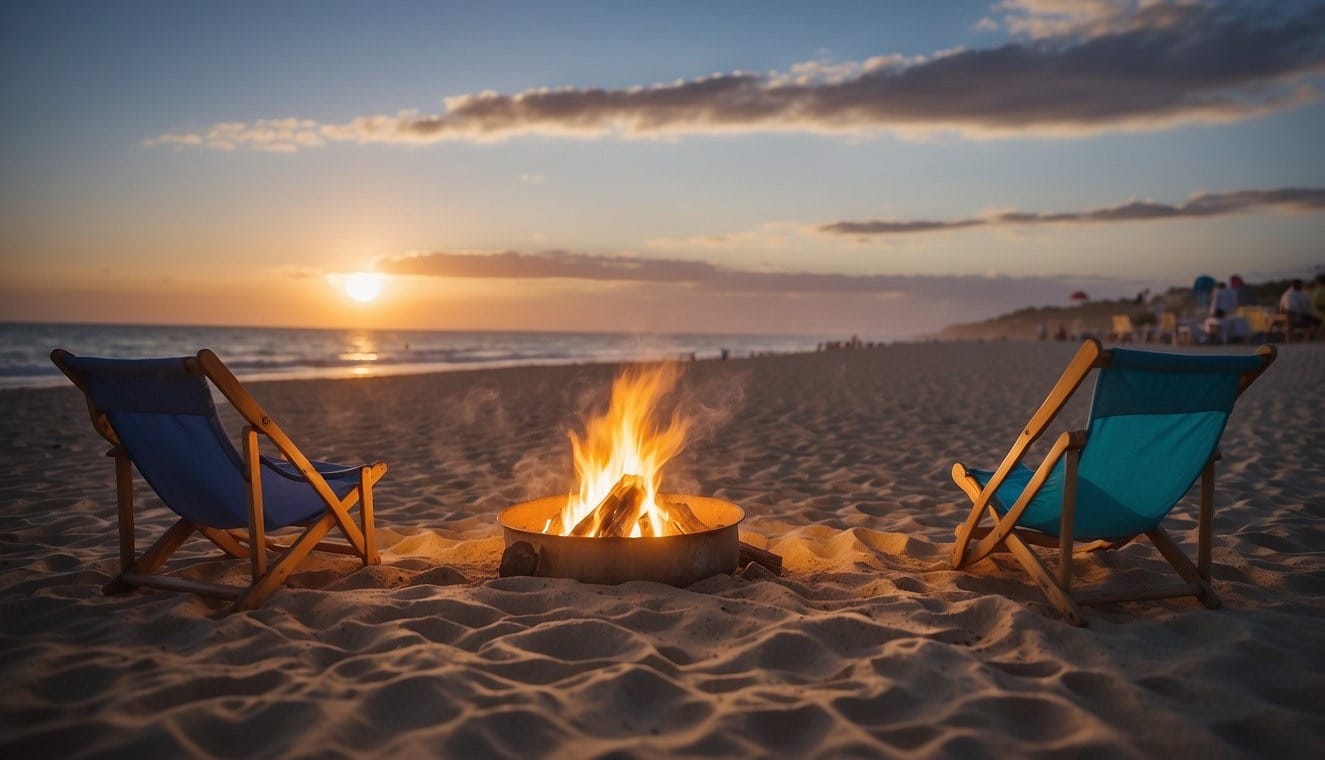
Preparation is key to a successful beach camping trip. You'll need to pack gear designed for the beach environment, including a tent that can withstand wind and sand, as well as sun protection and a way to secure food to avoid attracting wildlife.
Additionally, knowledge of beach camping etiquette and environmental conservation is vital. Leave no trace principles should guide your actions to maintain the beauty and health of the beach ecosystem for future visitors.
Key Takeaways
- Select a beach camping destination with the right amenities and permissive camping regulations.
- Prepare by packing appropriate gear and plan for beach-specific challenges.
- Practice Leave No Trace principles to preserve the beach environment.
Choosing the Right Beach Camping Destination
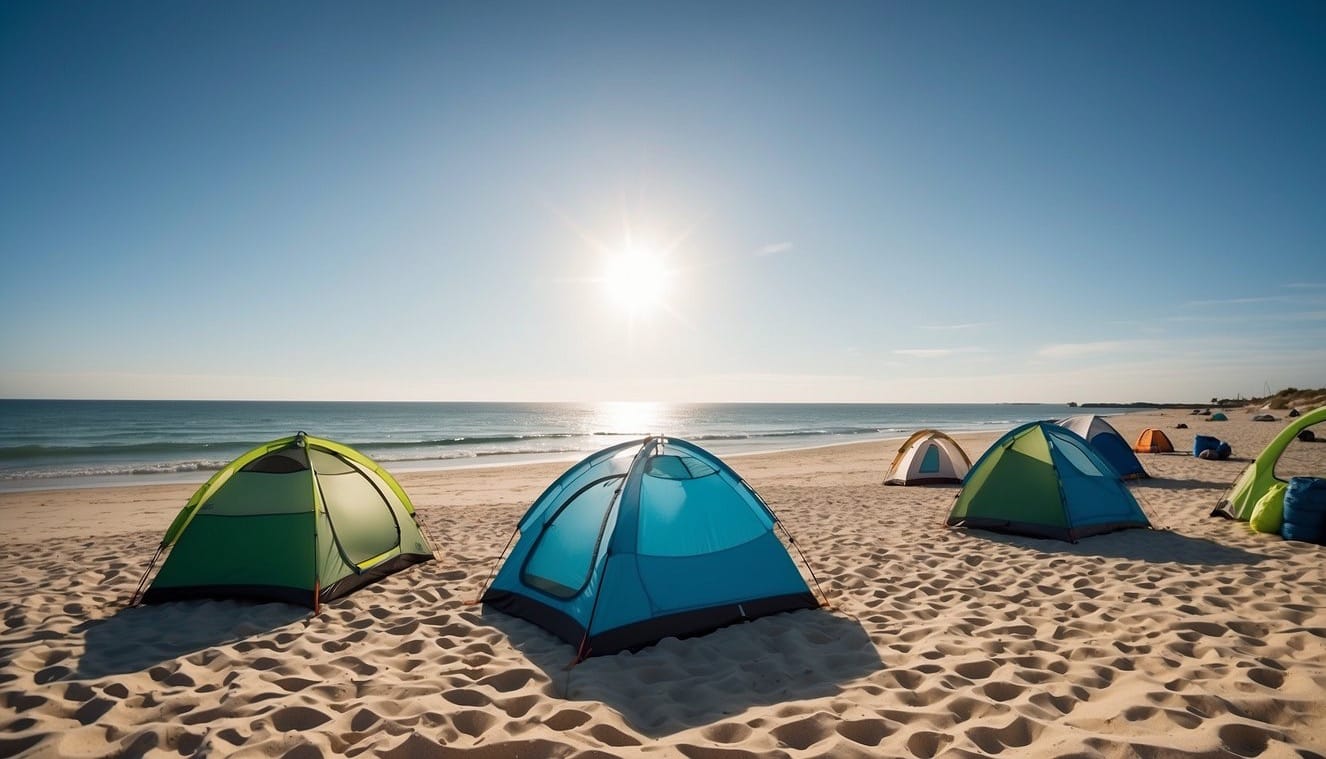
When planning your beach camping trip, the location is paramount. Selecting the right beach means balancing your desire for amenities and natural beauty with environmental considerations and regulations.
Evaluating Beach Types and Locations
Beach camping can significantly differ based on the type of beach and its location. You’ll want to consider the following aspects:
- Surrounding Water: Are you leaning towards the Gulf of Mexico with its warm waters, or the Pacific Ocean with its rugged coastline? Each body of water presents different climates, wildlife, and experiences.
- Sand Quality: Some beaches have fine, soft sand ideal for tent camping, while others might have coarser sand or pebbles.
- Tide Patterns: Be aware of high and low tides to avoid camping spots that might flood.
- Amenities: Determine what level of amenities you need. Do you want a developed campground with showers and toilets, such as Kalaloch Campground in Olympic National Park, or are you comfortable with primitive sites?
- Accessibility: How remote do you want your camping spot to be? Remote locations like Cape Lookout National Seashore may offer more solitude, but they require more effort to reach.
- Wildlife: If you're interested in wildlife, some beaches are near conservation areas or are known for their natural habitats, like Assateague Island National Seashore.
Best Beach Camping States
Here is a breakdown of some top states for beach camping, highlighting special locations and what makes them stand out:
- Florida: With a variety of options like the tranquil Bahia Honda State Park in the Florida Keys, or the more bustling Hunting Island State Park, you're sure to find a spot that suits your preferences.
- California: This state offers diverse coastal experiences, from the remote wilderness of Sonoma Coast State Parkto the popular Wright's Beach. The West Coast climate can range widely, so check local weather.
- North Carolina: Home to the stunning Outer Banks and places like Cape Lookout National Seashore, boasting rugged beauty and extensive coastline.
- Michigan: Although not on an ocean, Michigan has Hoffmaster State Park near Muskegon and the Apostle Islands National Lakeshore on Lake Superior, offering freshwater beach camping.
Preparing for Your Beach Camping Trip
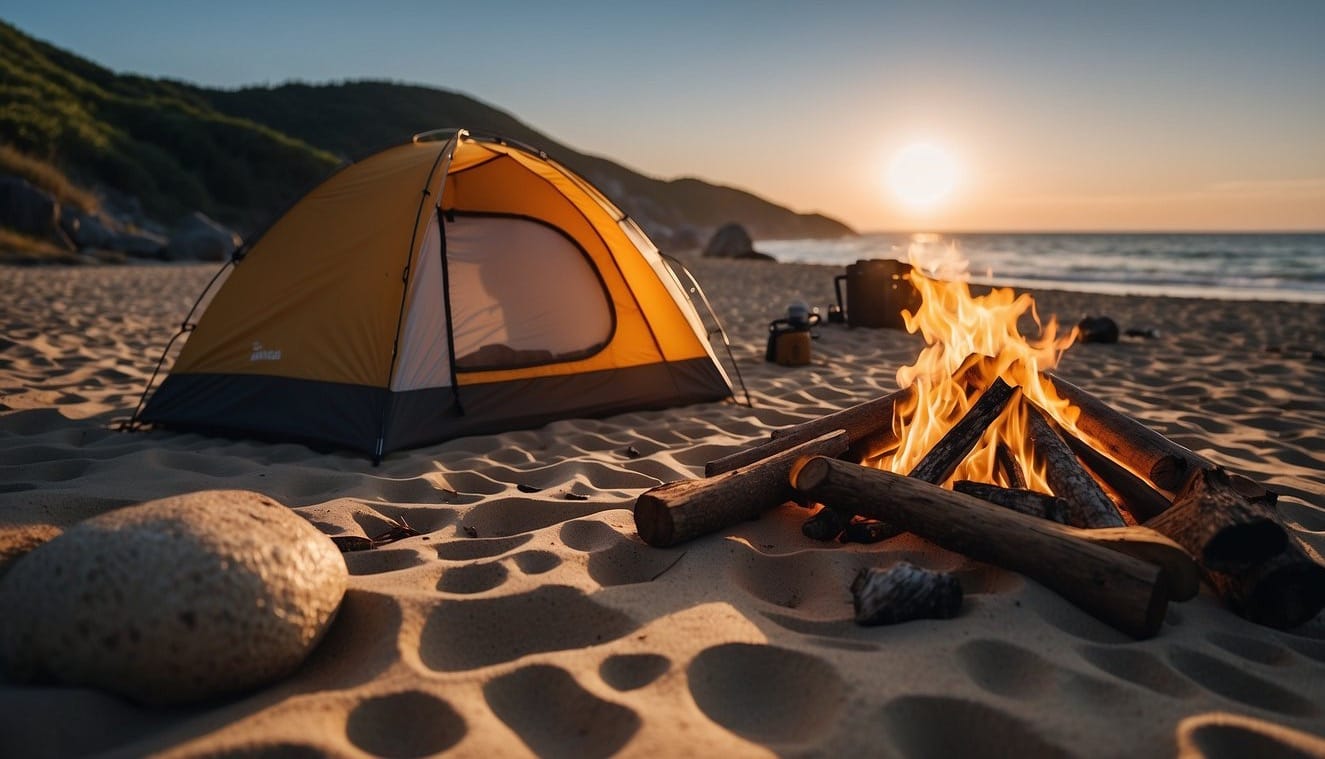
Embarking on a beach camping trip requires thoughtful planning and packing the right gear. From shelter considerations to dealing with varied beach weather, your preparation will dictate the comfort and success of your outdoor adventure.
Camping Gear Essentials
Shelter: Your tent is your home away from home, so ensure it's sturdy and appropriate for beach conditions. Look for a tent with robust tent stakes that can grip into sand and withstand windy conditions. A sun canopy or tarp can provide essential shade, especially when trees are sparse. Don't forget to pack a sleeping pad for insulation and comfort on the potentially uneven sand.
- Cooking and Water: Since beach areas may not have fresh drinking water, carry an ample supply. For cooking, portable stoves are more reliable than open fires, which can be prohibited or unsafe. Always pack firewood if allowed, and be mindful of the tides when setting up your cooking area.
| Essential Gear | Importance |
|---|---|
| Tent | Protection from elements, privacy |
| Sun Canopy/Tarp | Shade and shelter from the sun |
| Sleeping Pad | Comfort and insulation |
| Heavy-duty Tent Stakes | Securing tent on sandy grounds |
| Portable Stove/Cookware | Cooking meals |
| Drinking Water | Hydration |
Comfort and Safety: A hat will protect you from the sun, and always have clothing suited for the beach's seasons and temperatures. For safety, know the area's tides to avoid surprises and have a plan for securing food and waste to prevent attracting wildlife.
Weather Considerations
Understanding Weather Patterns: Before setting off, check the local weather forecast. If wind is expected, position your tent to minimize sand getting inside, and use a windbreak if necessary.
- Dealing with Elements: Be prepared for quick weather changes; carry waterproof gear and warm layers. Tides can influence the safety and accessibility of your campsite too, so familiarize yourself with the tidal schedule to avoid getting caught in high tide.
| Weather Factor | Consideration |
|---|---|
| Wind | Positioning of tent and use of windbreaks |
| Rain | Waterproof gear and proper tent sealing |
| Sun | Sunscreen, hat, and sun canopy for UV protection |
| Temperature | Clothes for warm days and cool nights |
| Tides | Campsite selection and timing of beach activities |
Setting Up Your Campsite
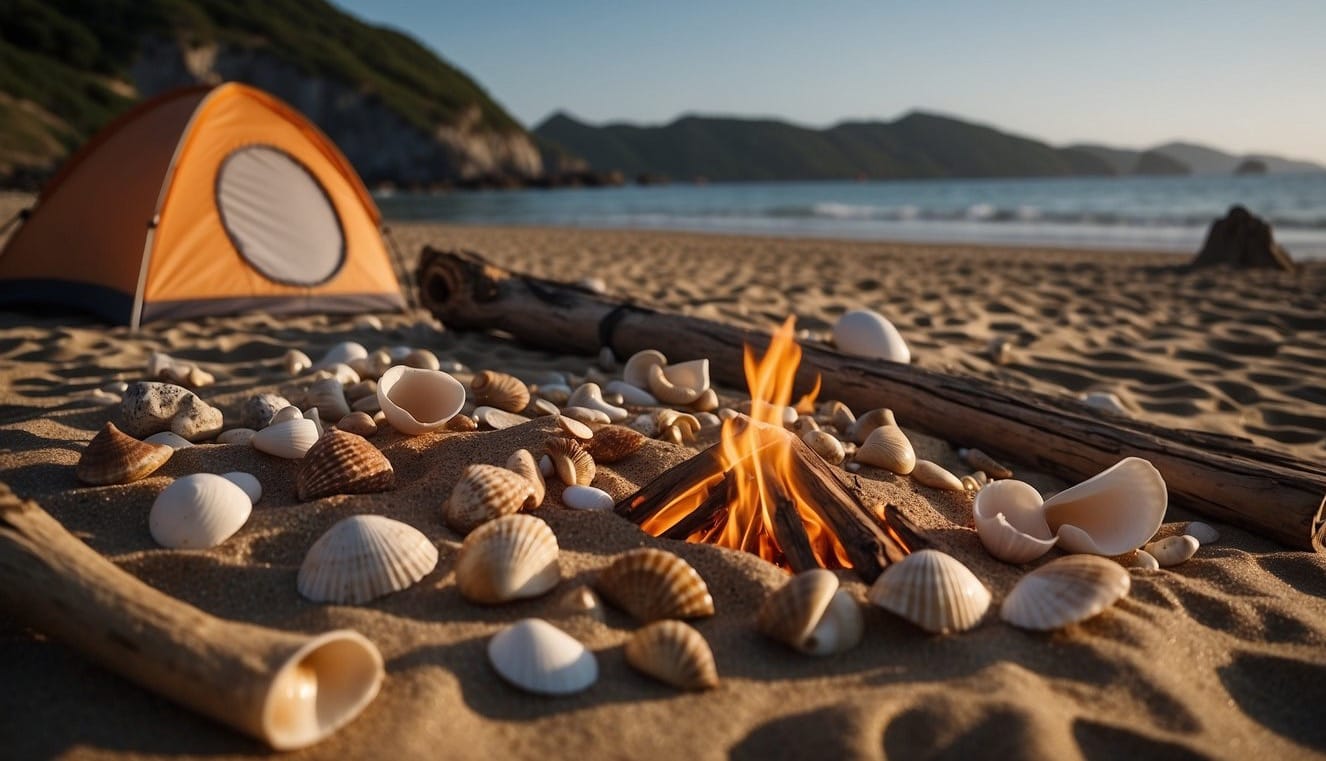
When setting up your campsite at the beach, your choices directly impact your comfort and the preservation of nature. It's essential to find a balance between an enjoyable outdoor experience and maintaining the health of the seaside environment.
Selecting the Perfect Spot
Location is key. Choose a spot on the beach that is above the high-tide line, ideally by observing where the debris has been naturally deposited and moving back an additional 20 feet to ensure safety. Look for natural windbreaks to protect your campsite from the ocean breezes. Sand dunes are off-limits for setting up camp because they are protected ecosystems, vital for the coastal environment. Instead, opt for flat areas where you won't disrupt nature.
- Avoid: Protected areas, such as sand dunes
- Seek: Natural barriers against wind, and flat surfaces without vegetation
Campsite Safety Tips
For your campsite's safety, always have a clear fire pit if campfires are allowed, ensuring it's a safe distance away from any flammable materials and wind-fueled directions. Keep in mind that beaches can be windy, which poses a risk for spreading fire. Portable fire pits are often a good choice for containing the flames.
In addition, find a spot that offers natural shade or set up a reflective tarp to evade the midday sun. Consider the need for seclusion if privacy is a concern, but don’t compromise on safety and environmental guidelines to achieve it.
- Fire Pit: Check regulations; use portable pits or designated areas
- Shade: Utilize natural shade or create your own with tarps
Activities and Entertainment
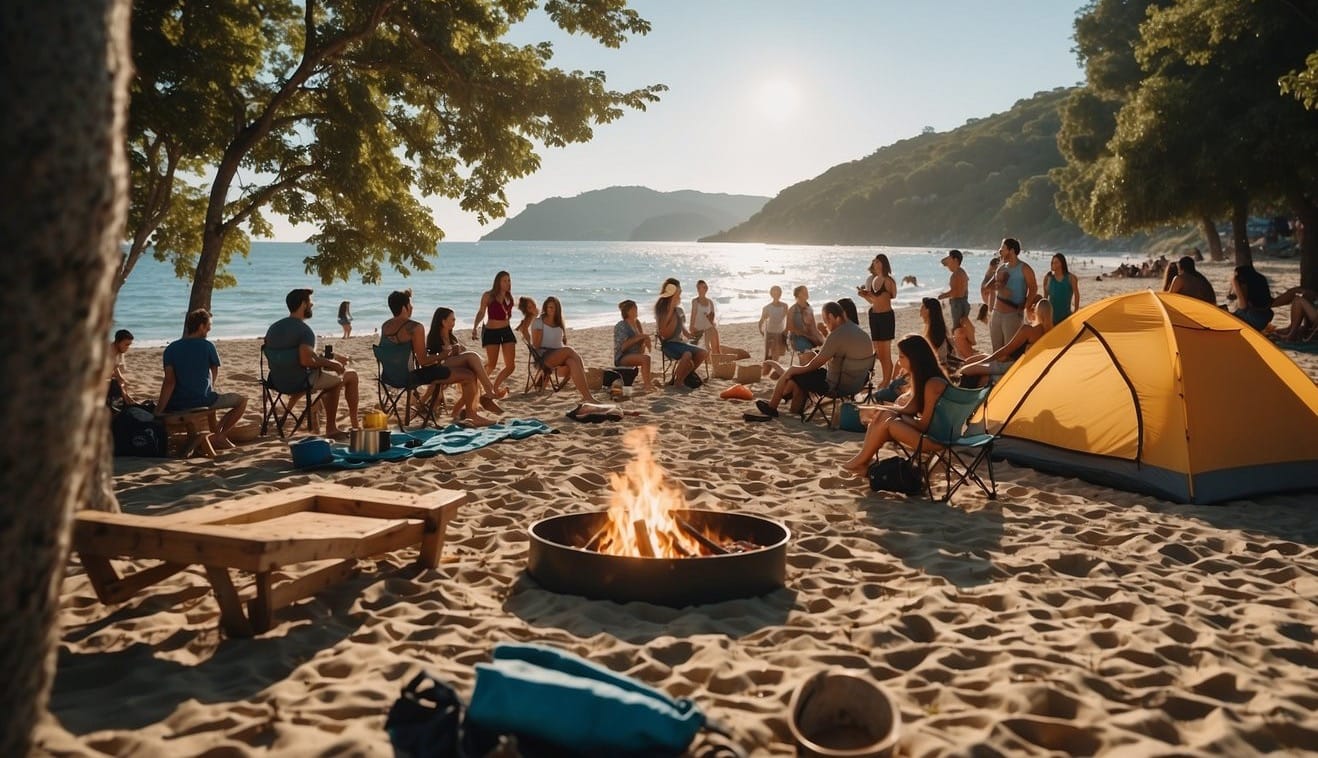
When camping on the beach, your days can be filled with exhilarating activities and your nights with memorable experiences by the sea. The rhythmic waves and the warm sun offer endless opportunities for fun and relaxation.
Daytime Activities
During the day, take advantage of the sun and surf for swimming and surfing. Ride the waves, embrace the saltwater, and feel the thrill of the ocean. For a more relaxed pace, try surf fishing; it's both calming and rewarding.
- Swimming: Monitor the flags for water safety and swim in designated areas.
- Surfing: Rent a board nearby, or take a lesson if you're a beginner.
- Surf Fishing: Bring your gear and spend peaceful hours waiting for a catch. Best during low tide or early morning.
Nighttime Experiences
As the sun sets, the beach transforms. Host a bonfire, where you can roast marshmallows and share stories under the stars.
The night sky offers a clear view of constellations—perfect for stargazing.
- Bonfire: Check local regulations first, then gather around for warmth and camaraderie.
- Stargazing: Bring a telescopic lens or simply lay back and enjoy the natural light display above.
DBNull
Beach Camping Etiquette and Conservation
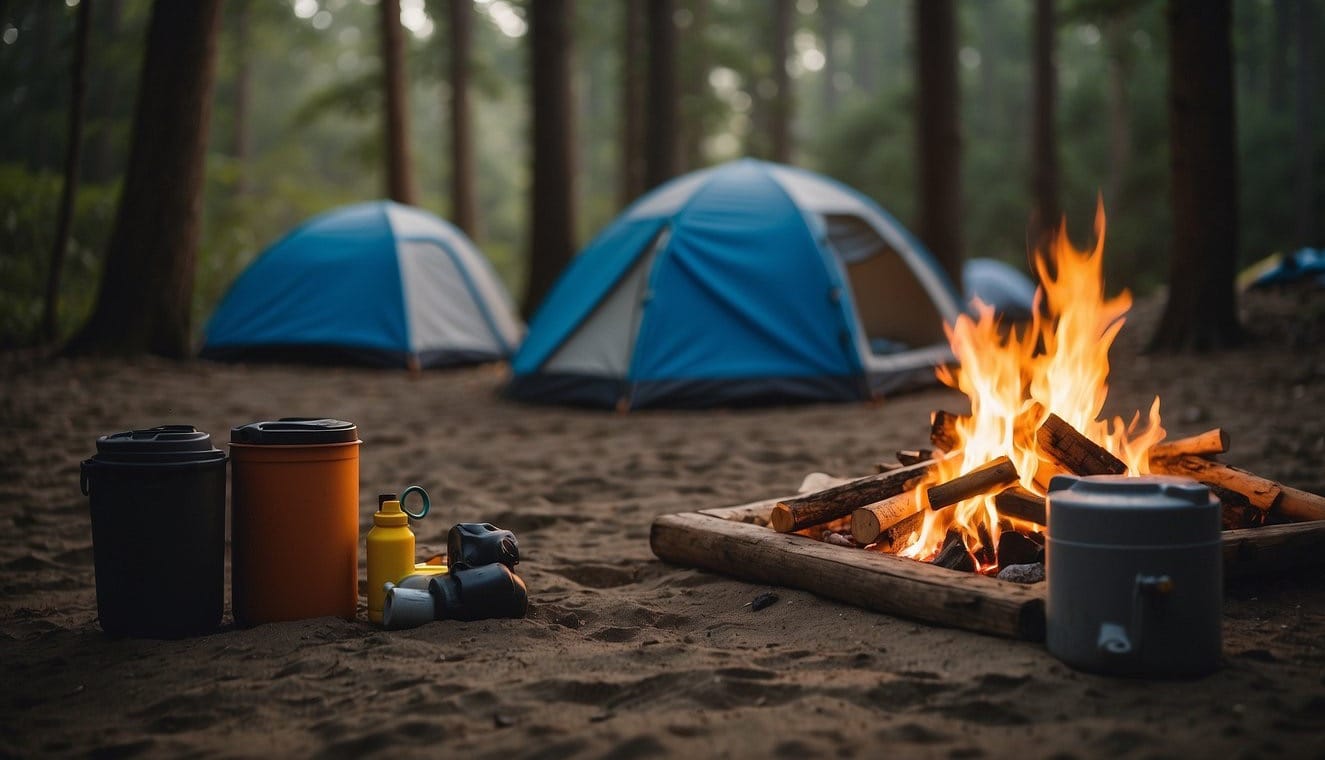
When camping on the beach, your actions have a lasting impact on the ecosystem. It's crucial to respect the local wildlife and flora while ensuring that you leave the beach as pristine as you found it.
Respecting Wildlife and Flora
Interactions with local wildlife, such as pelicans and sea turtles, should be minimal to avoid disturbances. Be mindful of nesting sites, especially during breeding seasons, and maintain a safe distance at all times to ensure their habitat remains undisturbed.
Do not pick or damage native plants, including palm trees, as they are essential to the beach's environmental health.
- Maintain Distance: Keep at least 50 feet away from animals.
- Do Not Feed: Feeding alters natural behaviors and diets.
- Watch for Nests: Sea turtle nesting sites are often marked, ensure not to disrupt them.
Leaving No Trace
The principle of leaving no trace is vital in preserving the beach's natural state for future visitors and the well-being of the ecosystem.
Pack out all trash, use biodegradable soaps when possible, and handle human waste properly.
- Dispose of Waste Properly: Bring bags to carry out all trash.
- Minimize Fire Impact: Use designated fire pits or avoid fires if not permitted.
- Bury Human Waste: Dig a small hole 6 to 8 inches deep and at least 200 feet away from water, trails, and camp sites to bury waste.
Navigating Challenges of Beach Camping
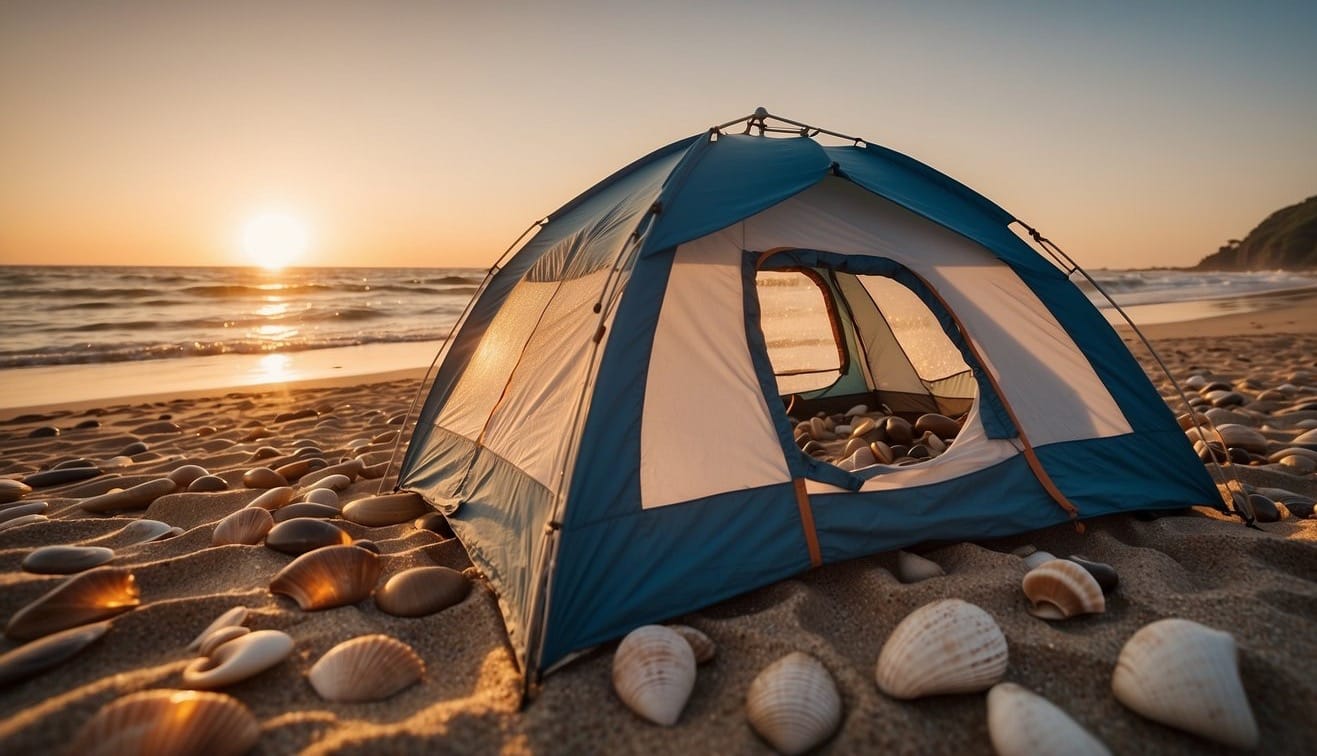
Beach camping offers unique experiences but comes with its own set of environmental challenges. Your enjoyment will largely depend on how well you adapt to these conditions.
Dealing with Sand and Saltwater
Sand: It's omnipresent at the beach, and managing it is crucial for a pleasant campsite experience.
To minimize sand intrusion, place a large mat at your tent entrance and store your belongings in sealed containers or bags.
When setting up your tent, look for flat areas away from the high tide line and use a ground cover to create a barrier against dampness and sand.
Saltwater: It can cause chafing, and dry skin if you're in contact with it frequently.
Rinse off with fresh water whenever possible to prevent salt buildup on your skin and gear.
It's also wise to set up your campsite away from direct contact with ocean waves which can erode the area and potentially wet your belongings.
Coping with Insects and Sun
Insects: Coastal areas are often home to biting insects.
Ensure your tent has no-see-um-proof netting and consider applying insect repellent. For added protection, bring along a screened dining canopy for meal times.
Sun: The beach offers little natural shade, increasing the risk of sunburn and heat exhaustion.
Always apply a broad-spectrum sunscreen with high SPF and wear a wide-brimmed hat.
Setting up a sunshade or canopy can also provide a much-needed respite from the sun.
Remember to hydrate regularly and opt for breathable, light-colored clothing to reflect sunlight.
Cooking and Food Storage
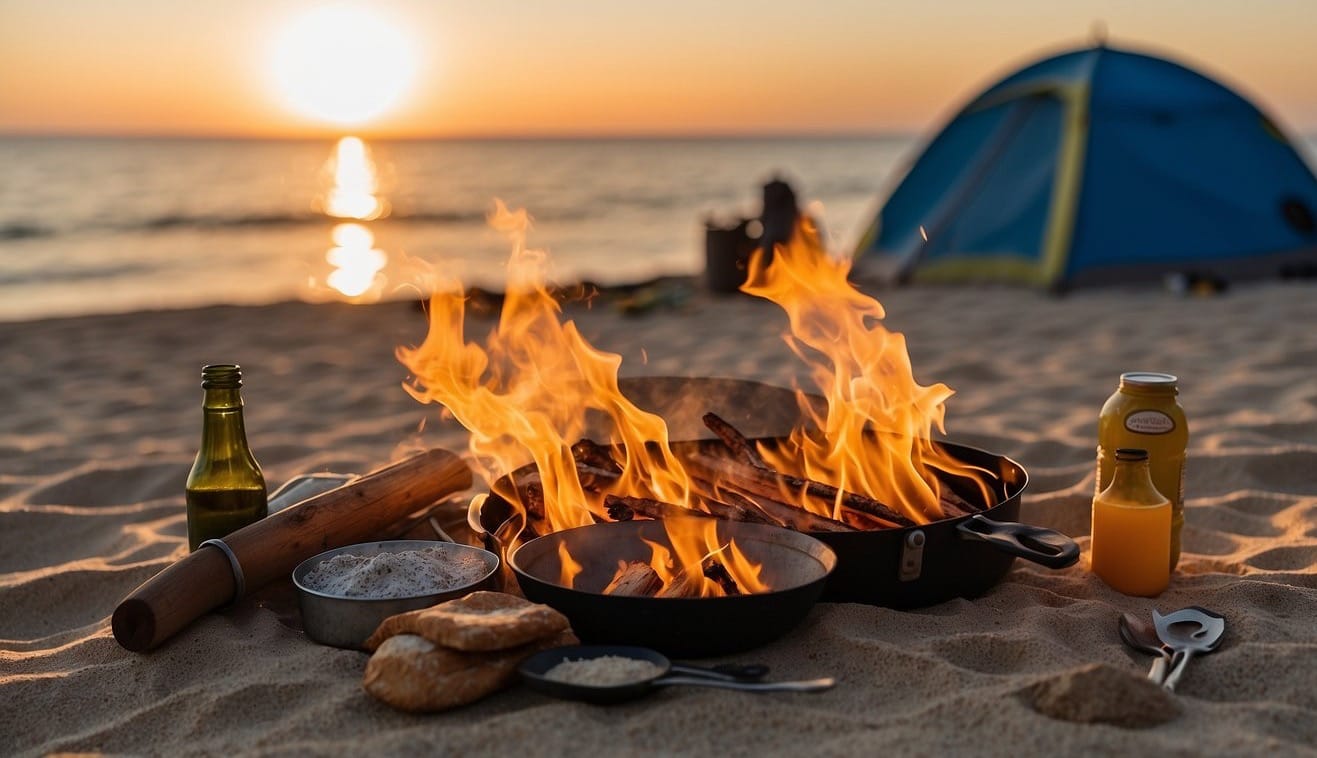
For a successful beach camping experience, you'll need to master cooking methods suited for the sands and ensure your food remains safe and unspoiled throughout your trip.
Beach-friendly Cooking Methods
Campfire Cooking:
- Check beach regulations regarding open fires.
- Use a fire pit or portable fire grate.
- Keep a water bucket nearby for safety and to extinguish the fire.
Propane Stoves:
- Choose a flat, stable surface away from sand and flammable materials.
- Always have spare fuel canisters.
- Monitor the stove while in use to prevent accidents.
Proper Food Preservation
Coolers and Ice Packs:
- Pre-chill your foods and drinks before packing.
- Separate raw and ready-to-eat items in different containers.
- Refresh ice packs regularly to ensure a constant cold temperature.
Bear-Proof Containers:
- Store all food, beverages, and toiletries securely.
- Place containers at least 200 feet away from the sleeping area.
- Use certified bear-proof containers in areas with bear activity.
Conclusion
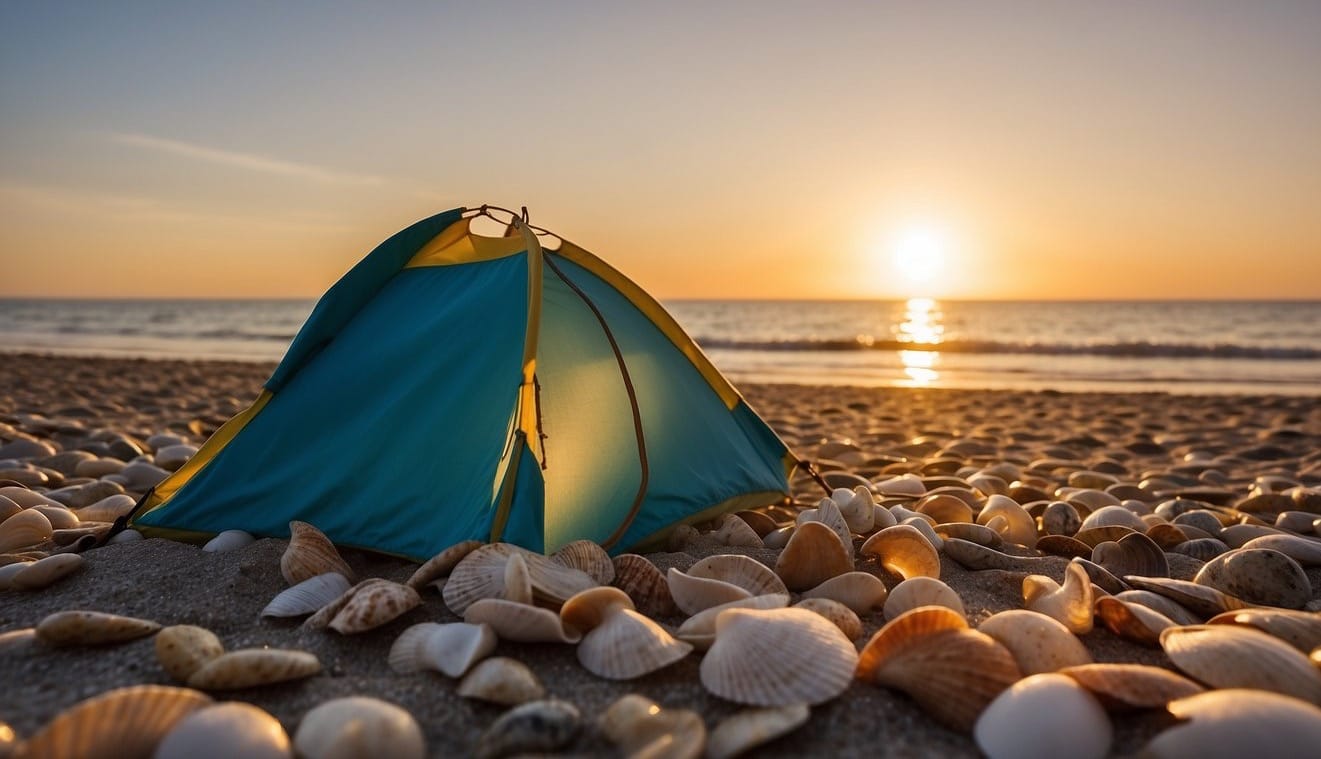
When embarking on your beach camping adventure, remember that preparation and respect for the environment go hand in hand.
By choosing the right gear and adopting a leave-no-trace ethic, you not only enhance your experience but also preserve the natural beauty for others.
Before You Leave:
- Ensure that all trash is picked up.
- Double-check that the campsite is left in its natural state.
Gear Checklist:
- Sun protection: Always pack sunscreen, a sun hat, and sunglasses.
- Clothing: Opt for light layers and breathable fabrics.
- Freshwater supply: Bring ample for hydration and rinsing off salt and sand.
Setting Up Camp:
- Select a spot away from the high tide line.
- Use a tarp under your tent for waterproofing.
- Flatten the sand beneath your sleeping area for a comfortable rest.
Beach camping provides a unique opportunity to capture memorable moments.
Take your camera or use your phone to take photographs but remember not to compromise on your environmental responsibilities while doing so.
Getty Images or similar resources can offer a glimpse of what successful beach camping looks like and serve as inspiration for your own journey.
Your experience can be both fulfilling and sustainable with a bit of forethought and care.
Enjoy the rhythm of the waves, the warmth of the sand, and the starry night skies as you make the most of your beach camping trip.
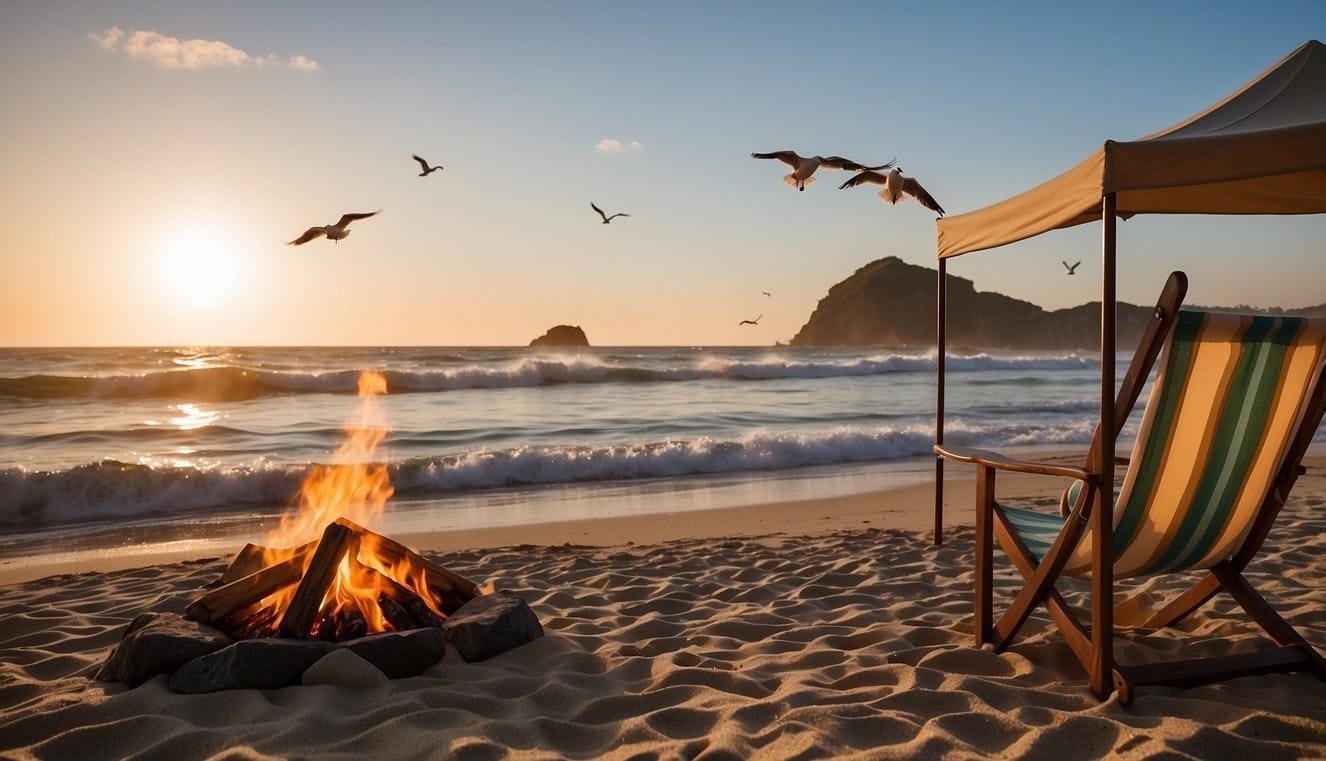
Frequently Asked Questions
Proper preparation can make or break your beach camping experience. Here are some frequently asked questions to guide you through the essentials of beach camping.
What are the essential items to bring for beach camping?
For beach camping, you'll want gear that withstands wind and sand.
Besides the basic camping paraphernalia, include sand anchors for your tent, a brush for sand removal, and biodegradable soap.
A water container for rinsing, and UV-protective gear such as a beach umbrella or a sun shelter, are also important.
What should I know before camping on the beach for the first time?
Understand the tide schedule to set your tent in a safe area and check weather forecasts to prepare for coastal conditions.
Know the local wildlife and plants to avoid any harmful encounters.
Always have a plan for clean water access and waste disposal to keep the beach pristine.
Are there specific permits required for beach camping in certain areas?
Many beaches require permits for camping, especially in state or national parks.
Research the requirements of your specific destination ahead of time. Permits can often be obtained online or at park visitor centers.
What are the best types of tents and gear for camping on sand?
Opt for tents with a sturdy, wind-resistant design, and select tent poles robust enough for sandy environments.
Choose a footprint or tarp for underneath your tent, and remember to bring extra stakes and guy lines for stability.
A sleeping pad is also crucial for comfort on the uneven sandy ground.
How do I keep my food safe and manage cooking while camping on the beach?
Use tightly sealed containers to protect your food from sand and animals.
Consider a portable cooler for perishable items.
For cooking, a camping stove is preferred over an open fire, not only for safety but also because many beaches prohibit open flames.
What clothing should I pack for a beach camping trip?
Pack clothing for a variety of weather conditions.
During the day, you'll need lightweight, breathable fabrics, sun hats, and UV-protective clothing.
For cooler nights, bring warmer layers.
Don't forget swimwear, along with a quick-dry towel.
Always have a rain jacket on hand in case of sudden showers.


